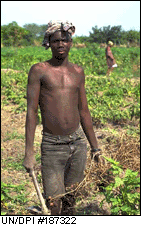|
|
The Brandt Proposals: A Report Card
Aid
 |
|
North-South called for a multilateral effort to provide aid to developing countries through international institutions. It advanced the idea that official development assistance not be given directly by one nation to another, but pooled at the international level, so that the benefits of aid might be more continuous, predictable, and evenly distributed among nations.
|
|
| The Brandt Commission also urged richer nations to contribute the official development assistance standard of 0.7% of their gross national product in aid, advancing toward one per cent before the year 2000. |
|
"We believe that the richer nations must continue to give special attention to the poorest countries to help them to help themselves. They should step up their aid, directing it with effective planning into the critical areas of the ecology. They should provide emergency assistance as an addition to the longer-term programs, not (as at present) as a large share of their total regular aid" (N-S, 88).
In 1951, developed nations were lending nearly 1% of GNP in aid. In 1980, it stood at 0.35%, and by the Millennium contributions from developed to developing nations had slumped to less than 0.21% of GNP. In addition, development assistance remains uncoordinated at the global level. There is a pressing need for a new institution – perhaps a restructured World Bank – to promote partnership among nations and institutions for the disbursal of aid on an equitable basis. |
|
| One area of progress is an increase in humanitarian assistance for victims of HIV/AIDS, including the efforts of the UN Secretary General in spearheading an effective program to combat this deadly disease. AIDS has killed 16 million people since 1980 and afflicts another 34 million people today, 95% of whom live in developing nations. Overseas development assistance, now at $57 billion per year, is mostly given bilaterally, with political and commercial strings attached. |
|
 |
|
Many nations and organizations do give generously, particularly in the area of relief for disaster-stricken nations. Too often, however, private donations, consisting of old products unwanted by donors, are given as tax write-offs. Just as tragic, aid transfers are often stolen by corrupt officials in developing nations. On the other hand, accusations of waste, fraud, and abuse have also provided a convenient excuse for developed nations to restrict the amount of foreign assistance they are willing to extend.
The administration of American President George W. Bush has taken the position that aid does not necessarily promote development, and that new controls must be instituted on the disbursal of foreign assistance through international institutions and national governments. In 2001, President Bush proposed issuing half of all World Bank aid in the form of restricted grants instead of low-interest loans, but this has been opposed by other G-7 nations on the grounds that World Bank reserves, once depleted, might not be replenished.
In early 2002, the US offered to increase its own foreign assistance by $10 billion between 2004 and 2006, and the European Union also promised to raise foreign aid by $25 billion through 2006, although both pledges are subject to broad loopholes. The twist in these proposals is that the issuance of development assistance is now contingent upon recipient countries demonstrating significant legal, political, and economic reforms to satisfy donor governments and foreign capital markets.
The difficulty with these new qualifications on foreign aid is that there is no agreement on how such reforms would be evaluated, nor are developing nations allowed input or dialogue on the eligibility criteria for this increased aid. It seems shortsighted to base international assistance on a developing economy's ability to meet the performance targets set by a liberalized global marketplace, when poor nations cannot stimulate enough investment and growth for development in the first place. |
| |
 |
|
Sophisticated markets expect developing nations to operate as emerging markets, often overlooking the fact that much groundwork is necessary to build a nation's infrastructure to the level where it can function as a viable market in the world economic system. The danger is that competitive standards for the evaluation of development levels might be used to deregulate international aid and lending, and increase private control and foreign ownership of government services in developing nations, effectively ignoring local need and impeding new development. |
|
Developed nations often call attention to their humanitarian largesse, but the aid flowing into poorer countries is still rather small compared with the debt payments that flow the other way. Poor nations continue to subsidize rich nations. The sum total of grants, trade, credits, direct private investments, and loans received from developed nations amounts to less than half of the interest and principal payments which developing countries end up paying back.
Essentially, what has been called 'aid' is money lent at interest that is often repaid to developed countries at two or three times the initial investment –a negative cash flow from poor to wealthy nations. In effect, aid is an inducement by developed nations to generate cheap exports from developing nations, which are obliged to acquire more and more foreign exchange to pay off their loans. This arrangement is simply winked at as good business, a double standard that passes for charity.
International aid is a classic expression of a perpetrator-victim relationship: the one manipulates but claims to act in good faith, the other pays twice for his own oppression. |
| |
| GRADE: D- |
|
|
|
|
|
|
|
|
|

